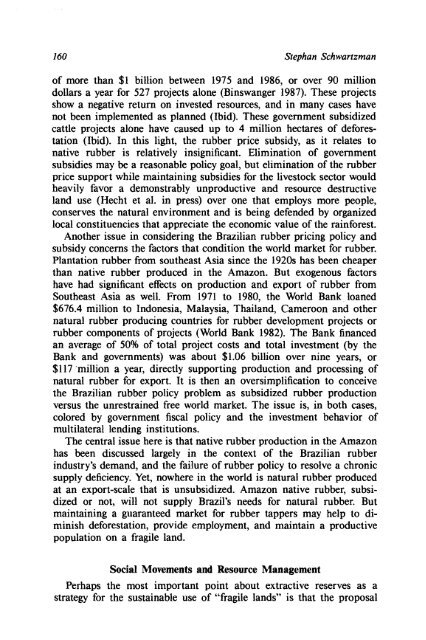Fragile Lands of Latin America Strategies for ... - PART - USAID
Fragile Lands of Latin America Strategies for ... - PART - USAID
Fragile Lands of Latin America Strategies for ... - PART - USAID
Create successful ePaper yourself
Turn your PDF publications into a flip-book with our unique Google optimized e-Paper software.
160 Stephan Schwartzman<br />
<strong>of</strong> more than $1 billion between 1975 and 1986, or over 90 million<br />
dollars a year <strong>for</strong> 527 projects alone (Binswanger 1987). These projects<br />
show a negative return on invested resources, and in many cases have<br />
not been implemented as planned (Ibid). These government subsidized<br />
cattle projects alone have caused up to 4 million hectares <strong>of</strong> de<strong>for</strong>es-<br />
tation (Ibid). In this light, the rubber price subsidy, as it relates to<br />
native rubber is relatively insignificant. Elimination <strong>of</strong> government<br />
subsidies may be a reasonable policy goal, but elimination <strong>of</strong> the rubber<br />
price support while maintaining subsidies <strong>for</strong> the livestock sector would<br />
heavily favor a demonstrably unproductive and resource destructive<br />
land use (Hecht et al. in press) over one that employs more people,<br />
conserves the natural environment and is being defended by organized<br />
local constituencies that appreciate the economic value <strong>of</strong> the rain<strong>for</strong>est.<br />
Another issue in considering the Brazilian rubber pricing policy and<br />
subsidy concerns the factors that condition the world market <strong>for</strong> rubber.<br />
Plantation rubber from southeast Asia since the 1920s has been cheaper<br />
than native rubber produced in the Amazon. But exogenous factors<br />
have had significant effects on production and export <strong>of</strong> rubber from<br />
Southeast Asia as well. From 1971 to 1980, the World Bank, loaned<br />
$676.4 million to Indonesia, Malaysia, Thailand, Cameroon and other<br />
natural rubber producing countries <strong>for</strong> rubber development projects or<br />
rubber components <strong>of</strong> projects (World Bank 1982). The Bank financed<br />
an average <strong>of</strong> 50% <strong>of</strong> total project costs and total investment (by the<br />
Bank and governments) was about $1.06 billion over nine years, or<br />
$1 17 'million a year, directly supporting production and processing <strong>of</strong><br />
natural rubber <strong>for</strong> export. It is then an oversimplification to conceive<br />
the Brazilian rubber policy problem as subsidized rubber production<br />
versus the unrestrained free world market. The issue is, in both cases,<br />
colored by government fiscal policy and the investment behavior <strong>of</strong><br />
multilateral lending institutions.<br />
The central issue here is that native rubber production in the Amazon<br />
has been discussed largely in the context <strong>of</strong> the Brazilian rubber<br />
industry's demand, and the failure <strong>of</strong> rubber policy to resolve a chronic<br />
supply deficiency. Yet, nowhere in the world is natural rubber produced<br />
at an export-scale that is unsubsidized. Amazon native rubber, subsi-<br />
dized or not, will not supply Brazil's needs <strong>for</strong> natural rubber. But<br />
maintaining a guaranteed market <strong>for</strong> rubber tappers may help to di-<br />
minish de<strong>for</strong>estation, provide employment, and maintain a productive<br />
population on a fragile land.<br />
Social Movements and Resource Management<br />
Perhaps the most important point about extractive reserves as a<br />
strategy <strong>for</strong> the sustainable use <strong>of</strong> "fragile lands" is that the proposal

















